

Purpose:
- Here to talk to you about oral piercings and the effects they have on your oral health.
Introduction to Poster Board by Paige White
What Oral Piercings Are?
- Oral piercings are cosmetic piercings of the oral cavity for insertion of objects such as rings, studs or plastic pins
- Involves all features of the tongue, lips or cheeks
- To name a few: Tongue Piercings, Lip Piercings, Frenulums (show photos to group)
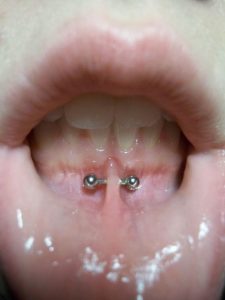


History of Oral Piercings:
- Oral piercings date far back as 4000-5000 years ago between the 14th and 16th centuries. They have found preserved bodies with piercings.
- Facial/Oral piercings were believed to be a way to identify specific groups, whether it be religious, tribal, gang members, marriage or financial statues or to solely beautify the body.
- Aztecs and the Mayan civilizations would perform tongue piercings as a form of blood sacrifice. This was done by priests or shamans who thought that by piercing their own tongues they could communicate with the gods through an altered state of consciousness.
- In Africa, tribal communities often have lip piercings or stretched their lower lip with plates. These were done for several reasons, to represent the creation of the world or used as a marriage state.
- Mursi people in Ethiopia have plates infused to their piercings for aesthetic reasons.
- Cultures in Sudan believe that lip plates are the equivalent to men’s facial hair. (beards and moustaches)
- As you can see, there is no one specific reason why people choose to get piercings in or around their mouth. Several reasons account for people choosing to pierce themselves.
- It has become less popular to have facial piercings in today’s western society due to inability to get a job, scrutiny from peers – being labelled goth or punk. Whereas, cultures in Africa still hold piercings to a high religious standard.

Types of Oral Piercings by Lily Souliotis
- Frowny piercing- this is located on the bottom web between the lip and teeth known as the frenulum.
- Smiley piercing- this piercing is located on the upper part of the frenulum.
- Venom bites- this is a double tongue piercing that is located on both sides of the tongue.
- Monroe piercing- this piercing sits above the upper lip on the left side of the face.
- Dahlia piercing- involves two piercings that sit on the corners of the mouth.
- Dolphin bites- consists of two piercings beneath the center of the bottom lip.
- Gum piercing- this is usually located in between the two upper front teeth.
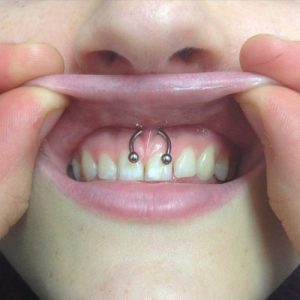
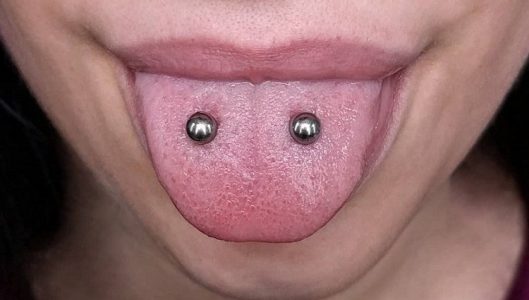
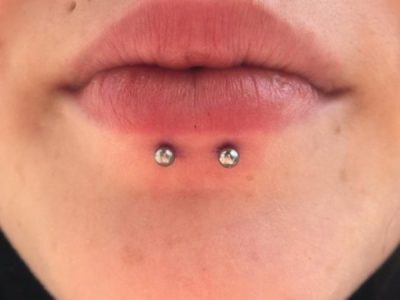
Complications of Oral Piercings:
When someone is considering getting a piercing, they should be made aware of the risks to getting a piercing.
- Bacterial infection can occur at the site of the piercing, which may result in blistering, pus and redness.
- Heavy jewelry can traumatize the tissue and can lead to an excessive amount of plaque.
- A common habit of biting or fiddling with your piercing can cause damage to gums, teeth and fillings which may lead to sensitive or cracked teeth.
- When getting a tongue piercing, you may experience excessive drooling caused by an increase in saliva production.
- Jewelry that is too small can cut off blood supply, which then may lead to surgery.
- All or part of the jewelry can come loose, resulting in choking, aspiration or swallowing.
- Oral piercings can interfere with diagnostic procedures by blocking X-rays.
- Allergic reactions can arise from the jewellery material.
- Improper chewing, speaking or swallowing can occur when having an oral piercing.
- Gingival recession may form, which can increase sensitivity and root caries
- After getting a tongue piercing, you may experience a numb tongue, this is caused by nerve damage that is usually temporary, but can sometimes be permanent.
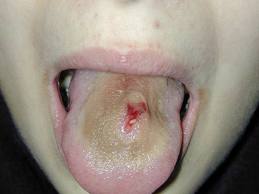
Still Considering? by Breanna Montague
- In the first 3-5 days, it is common to have significant swelling, light bleeding, bruising and tenderness in the area of the piercing.
- To reduce swelling, use ice chips and allow them to melt in the mouth.
- Do not speak or move the jewellery more than necessary.
- If any bleeding occurs, press the area with a clean washcloth.
- Clean oral piercings with mouthwash, rinse with an alcohol-free mouthwash. The best way is with a sea-salt mouthwash.
- Swish your mouth for 5 full minutes per session 2-3 times a day and rinse briefly (for 30 seconds or so) after eating anything.
- Once the piercing has healed, gently brush it to remove plaque using a new soft-bristled toothbrush to prevent the introduction of bacteria into your mouth.
- Don’t fiddle with your piercing, do not touch or twist. If the piercing must be removed or touched, make sure you use clean hands.
- Consider removing jewellery if you plan on doing any strenuous activities to avoid injuries of the mouth and teeth.
- Implant grade stainless steel, titanium and niobium are preferred materials for quality jewelry that help speed up the healing process but it is preferred to have plastic rings, bars, studs because you have less chance of risking gum recession or chipping of teeth.
Preventions:
- If you decide that you still want a piercing, try and use plastic over metal as this is the safer option and will reduce the chance of calculus formation and chipping of the teeth.
- Implant grade stainless steel, titanium and niobium are preferred materials for quality jewelry that help speed up the healing process but it is preferred to have plastic rings, bars, studs because you have less chance of risking gum recession or chipping of teeth.
- Good oral hygiene + regular dental check ups will help prevent possible infection of the piercing.
- Make sure the correct after-care routine is followed and keep jewellery in place to promote healing.
- Know the signs of infection: yellow or green discharge, increased redness, pain or swelling/tearing, low grade persistent fever, thick dark tissue that builds up around the site.
- If you suspect infection, seek professional care. Keep jewellery in place to encourage drainage. Do not remove the jewellery as the surface can heal and trap the infection, resulting in an abcess.
PLAY GAME by all group members
MATCHING GAME:
- Reach into the jar to grab a piece of paper that contains a specific type of piercing.
- Retrieve a jewel to stick onto the mouth model provided, to determine where you think that particular piercing would get placed.
- Refer to cards provided with photos of each piercing, if needed, to see if the player’s placement was correct.
- If placement was correct, the player wins a sticker!
PLAY GAME HERE:
Match the name of the piercing to the photo of the piercing!
GAME CARDS
Names of the piercings for the game cards~
- Dolphin bites.
- Frowny.
- Dahlia.
- Smiley.
- Tongue.
- Snake bites.
- Venom bites.
- Monroe
- Uvula
- Tongue Web
- Gum



ANSWER KEY:
- Dolphin bites

2. Tongue piercing

3. Dahlia piercing
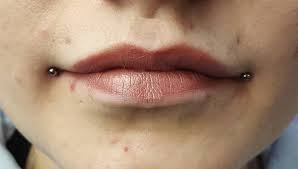
4. Frowny piercing

5. Snake bites

6. Monroe piercing
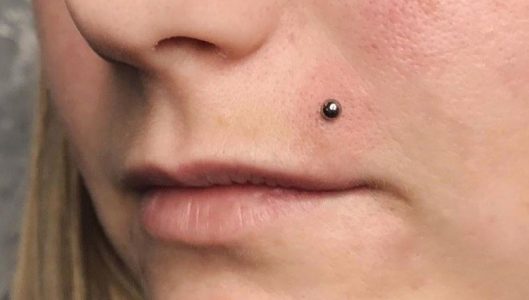
7. Gum piercing
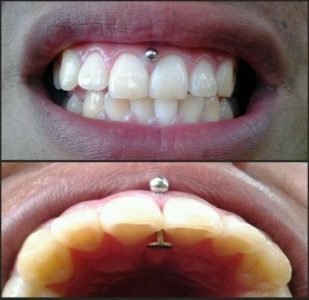
8. Tongue web piercing
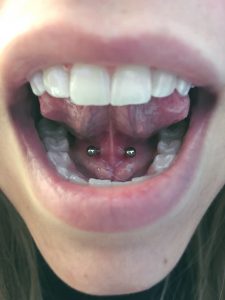
9. Smiley piercing
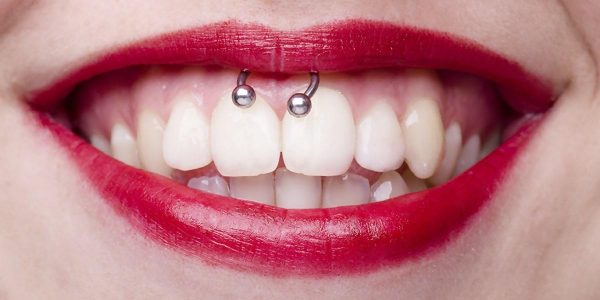
10. Venom bites

11. Uvula piercing

https://allthatsinteresting.com/history-of-piercing/4 https://www.dentalcare.com/en-us/professional-education/ce-courses/ce423/types-of-oral-piercing-jewelry http://www.piercing-ideas.net/8-strange-facts-tongue-rings/ https://www.mouthhealthy.org/en/az-topics/o/oral-piercings https://advancedsmilecare.com/tooth-jewelry-trend-is-it-okay-for-my-teeth/ https://dentagama.com/news/oral-health-risks-of-tongue-piercings



